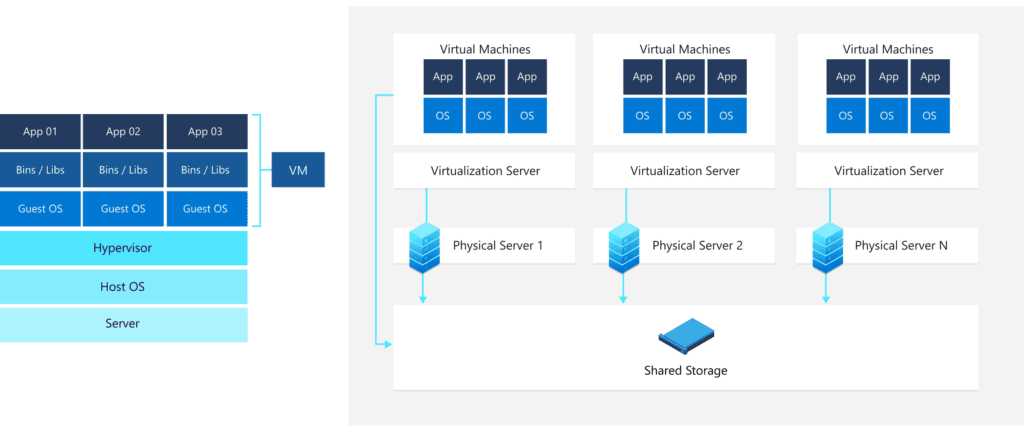What is a Virtual Machine?

A virtual machine (VM) is an emulated or digital version of a physical computer. Virtual machines can be used to run different operating systems and applications, store data, connect to networks, as well as perform other tasks like a physical device. Virtual machines run on a physical device called a host or parent server. And a virtual machine is called a guest or child.
In this article, I’ll explain how virtual machines work and how they differ from containers. I’ll also detail some of the most important use cases for virtual machines, including cross-platform software development and malware investigation.
How does a virtual machine work?
Essentially, virtualization technology allows users to create and run multiple virtual machines simultaneously on a single host. For instance, a Windows host is capable of running different virtual machines with Windows, CentOS, Ubuntu, and other Linux distributions.
A virtual server uses hypervisor software to interact with the underlying physical hardware. It makes it possible to keep VMs separate and evenly allocate host resources (CPUs, storage, and memory) to each VM guest as needed. The hypervisor can also schedule operations to prevent deadlocks.

The two types of hypervisors
There are two primary types of hypervisors that are used in virtualization.
Type 1 Hypervisors (Process VM)
First up, a type 1 hypervisor, also called a bare-metal hypervisor, runs natively on the physical computer. Typically, a separate management tool is required for creating/managing virtual machines and managing permissions on the hypervisor. Microsoft Hyper-V and Citrix Hypervisor are examples of type 1 hypervisors.
Type 2 Hypervisors (System VM)
A type 2 hypervisor, also known as a hosted hypervisor, can run as an application on the host OS. It allows users to manually create a virtual machine instance and install a guest operating system.
The type 2 hypervisor is comparatively slower because each virtual machine request must be routed to the host operating system. It is suitable for individuals, developers, and small companies that can’t afford to purchase dedicated servers. Some common examples of type 2 hypervisors include Oracle VirtualBox and VMware Workstation.
What is virtualization?
Virtualization is a technology that involves the creation of an abstraction layer over a physical host machine. It helps to divide hardware resources (CPU, RAM, and storage) of a single computer into different virtual computers called virtual machines.
Each virtual machine acts as an independent machine with its own operating system. It is a cost-effective solution for organizations that want to run multiple operating systems and applications on a single physical server.
The five types of virtualization
There are five common types of virtualization: Hardware, software, storage, network, and desktop virtualization.
1. Hardware virtualization
Hardware virtualization, also known as server virtualization, is a technique that allows users to create virtual versions of computers and operating systems. It makes it possible to simultaneously run multiple operating systems on the same physical machine. Hardware virtualization also optimizes the utilization of hardware resources.
2. Software Virtualization
Software virtualization is a method that enables a physical host machine to run multiple virtual computers. It leverages hypervisor software to distribute the hardware resources (such as storage, processors, and memory) among different virtual machines (VMs). For instance, a Linux distribution can be run in a virtual machine on a computer that is running a Windows operating system.
3. Storage Virtualization
Storage virtualization consolidates the physical storage from multiple network storage devices to appear as a single virtual disk. It has various benefits including reduced costs, load balancing, disaster recovery planning, and improved performance and speed.
4. Network virtualization
Network virtualization is a process that is used to group physical networks into a single software-based virtual network. It helps to distribute the available bandwidth into various channels and allocate them to devices and servers. It offers benefits such as improved security, reliability, and network speed.
5. Desktop virtualization
Desktop virtualization enables users to simulate a workstation load so that it can be accessed from anywhere on any device. Its primary benefits include cost savings, resource optimization, enhanced data security, and easier management.
What are the main benefits of using VMs?
VMs provide various benefits to both end-users and IT administrators. Here is a list of some of the features that make virtual machines very attractive in enterprise environments:
1. Cloud computing
Virtualization technology provides the basic architecture for cloud computing. It enables businesses to deploy and migrate cloud-native virtual machines to on-premises server environments and to leverage hybrid clouds.
It is also possible for organizations to allocate and change cloud resources in real-time to meet their dynamic usage requirements. Cloud-based VM services are popular for running SaaS applications, backing up data, and hosting email & access management services.
2. Cost efficiency
Virtual machines allow organizations to create and run multiple virtual machine instances on a single server. As IT hardware costs can be a real challenge for businesses, VMs can help increase cost efficiency by using minimum physical hardware resources. For example, IT admins can use a single server machine to deploy different applications in an enterprise environment.
3. Security
Users can create virtual environments to boost security and prevent malware from impacting the underlying hardware and operating system. It is possible for users to quickly and easily revert a compromised VM to older versions in case of a cyber attack.
Meanwhile, developers can use VMs to test software updates and apps before releasing them to production users. VMs are also helpful for researchers to test malicious software.
4. Scalability and portability
Virtualization allows customers to rapidly deploy different types of VMs with the operating systems of their choice and a specific set of resources. VMs can also help organizations to better respond to variations in workloads. They can also save the extra time and effort required to install different operating systems on physical servers.
5. Workload migration
Virtual machines are referred to as “self-contained packages” that are decoupled from the physical computer. This makes it easier for IT teams to migrate to faster hardware, move a VM from one server to another, as well as recover from failures.
6. Disaster recovery
Organizations can use virtual machines to back up their systems in cloud environments. This capability provides an additional layer of security and minimizes the risk of data loss in scenarios such as hardware failures.
7. DevOps support
VMs provide maximum flexibility in supporting enterprise developers. They can create isolated environments with complete functionality for the software development and testing process. VMs also allow developers to run and test incompatible software on different operating systems.
Virtual Machines vs. Containers
Just like virtual machines, containers make it possible to run applications that are isolated from the underlying host. However, let’s take a closer look at the major differences between virtual machines and containers:
| Virtual Machines | Containers |
|---|---|
| Hardware-level process isolation | Operating system-level process isolation |
| A virtual machine offers complete isolation of apps from the host OS | Containers can share some resources with the host OS |
| VMs use a few GBs of system memory | Containers require less memory space (KBs or MBs) |
| Each VM has a dedicated OS | Containers can share OS resources |
| VM is more secure | Containers are less secure |
| Boots in minutes | Boots in seconds |
| VMs consume more system resources | Containers consume fewer resources |
| VMs can move between hardware | Containers are destroyed and recreated |
| VM creation takes a considerable amount of time | Users can create containers within a few seconds |
| Users can run any OS inside the VM | Users can only run containers on the same OS version as the host |
| Some popular use cases of VMs are running multiple applications, monolithic applications, and legacy apps on older OS. | Containers are best for running web apps, DevOps testing, and microservices. |
The main use cases for virtual machines
Virtual machines have several use cases for both end-users and IT administrators. Here are a few examples:
1. Test new operating systems
Virtual machines enable users to run different operating systems on a single physical host. This means that users can test new features without affecting their primary operating system.
If you’re a Windows Insider, you may be tempted to use virtual machines to test Windows 11 preview builds coming from the Dev channel. These builds can be pretty unstable, though it’s possible to recreate the virtual machine and reinstall the operating system if your VM fails to boot for some reason.
2. Run legacy or incompatible software
Another common use case of virtual machines is the ability to use legacy software applications in enterprise environments. VMs allow users to run software that is not supported by their existing operating system.
3. Malware investigation
Malware researchers often need new machines to test malicious programs or applications. This is where virtual machines come in handy. They can test the software in a VM rather than risk infection on the physical host.
4. Cross-platform software development
Virtualization technology enables software developers and testers to test their applications across multiple platforms. For instance, a team of developers can use various virtual machines to test different versions of an app in an emulated environment.
5. Training Sessions
It is important for training room computers to run various instances of operating systems. Virtual machines let trainers conduct training sessions that replicate different business scenarios and environments.
6. Secure browsing
Lastly, virtual machines can help to ensure a secure browsing experience for users. It is possible to take a snapshot of a VM in its current state and then roll it back in case of malware infection. Users can either set up a Type 2 hypervisor or ask an IT admin to grant them temporary access to a virtual desktop hosted on a server.
Conclusion
In a nutshell, virtual machines are a cost-effective solution that allows IT teams to efficiently distribute system resources and manage large clusters of computers. However, VMs have various pros and cons, and organizations typically use a hybrid approach (both physical and virtual machines) depending on their business needs.



